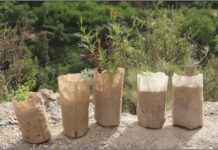By Lawrence Paganga
A Tanzanian bean breeder is working with a US dry-bean breeder based in Nebraska in a new connection that might open a channel of international collaboration to improve dry edible beans and help improve nutrition and food security in Eastern and Central Africa.
University of Nebraska-Lincoln Panhandle Research and Extension Centre at Scottsbluff.
Carlos Urrea is the dry bean breeding specialist at the University of Nebraska-Lincoln Panhandle Research and Extension Centre.
His work is on breeding better bean varieties for Nebraska, one of the US’s leading bean-producing states.
Teshale A. Mamo, based in Arusha, Tanzania, is a bean breeder by profession, and also a coordinator of the bean research network for East and Central Africa for the Alliance of Biodiversity International and CIAT, the International Center for Tropical Agriculture.
The international non-profit organisation’s missions include reducing hunger, improving nutrition, and improving agricultural eco-efficiency.
Mamo coordinates dry-bean research activities in 10 African countries namely: Ethiopia, Kenya, Tanzania, Rwanda, Burundi, the Democratic Republic of Congo (DRC), Madagascar, South Sudan, Uganda, and Sudan.
The two men met recently for the first time in the US at Urrea’s office at the Panhandle Centre.
While in the US, Mamo has also travelled to North Dakota State University to meet with bean breeder Juan Osorno.
Osorno is a frequent collaborator of Urrea’s in joint research projects and regional nurseries where bean cultivars are tested in plots around the US.
Urrea’s programme also has an extensive reach, with winter bean breeding nurseries in Puerto Rico and New Zealand. In addition, he travels to Colombia annually, his country of origin, to visit CIAT (based in Colombia) and select dry bean lines to bring back and use in his efforts to breed for drought and heat resistance.
He also collaborates with bean researchers in Uganda, Zambia, and Mozambique.
Through his connections Mamo learned of Urrea’s programme, including heat and drought tolerance.
“I am really excited by his (Urrea) work, and I asked to visit his breeding programme, and that is why I travelled 10 hours,” Mamo said.
The two men also visited executive director Lynn Reuter at the Nebraska Dry Bean Commission office.
Urrea showed Mamo some of the results of his programme, such as bean lines with resistance to root rot and common bacterial blight, and a pinto bean cultivar that has been released for use in Africa.
According to Urrea, they also looked at experiments on heat and drought. He showed Mamo laboratory equipment used in bean cooking tests and for the development of slow-darkening pinto lines.
Urrea explained the extension component, which involves activities such as field days, multi-state collaboration, and publications and websites that share data and new information with the public.
Mamo said he was interested in talking about breeding tolerance to drought and heat, resistance to diseases, and other traits that farmers prefer and consumers demand.
In Africa, the most popular market classes of beans are red mottled, yellow beans, small red, sugar beans, navy beans, and pintos.
The breeding programme in Pan-Africa Breeding Bean Research Alliance/CIAT has focused on those grain types by looking at consumers’ preferred traits, including good flavor, fast cooking time, and low flatulence, Mamo said.
In most African countries, beans are a staple food used in various ways.
They are often served in soups, snacks, stews and porridge and ground into flour to make doughnuts.
According to Mamo, per-capita consumption in countries such as Rwanda, Kenya, and Uganda reaches 50-65 kilograms, and in Tanzania, consumption is 20 kilograms per person per year.
After the meeting, Mamo and Urrea said they were working on bringing several young bean-breeding students from Rwanda, Tanzania, Burundi and other African countries to the Panhandle Centre for several months for hands-on experience and learning.
Rwanda is a large consumer of dry beans, Mamo said, and Tanzania is the No. 1 bean-producing nation in Africa, and seventh in the world, in terms of acreage and tonnage.
The two men said the breeding plots in Scottsbluff have several promising cultivars for Africa. Mamo said the 10 countries, he works with needed assistance, including technical support and project proposal writing.
Caption: Urrea (left) and Mamo, Urrea’s research plots in Scottsbluff.









